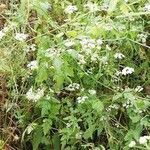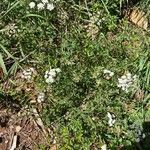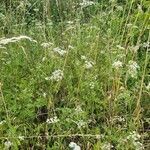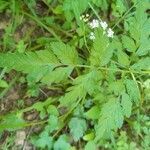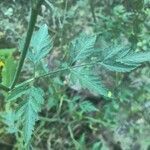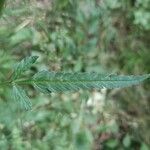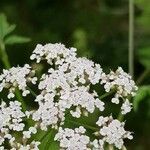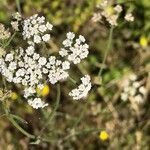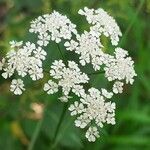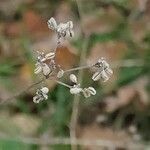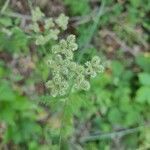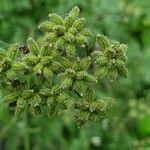Stems to more than 1 m, finely striate, rough by appressed bristles. Leaves triangular in outline, sparingly appressedly hirsute, pinnate, leaflets pinnatipartite, segments pinnatifid to serrate. Umbels terminal and axillary; peduncles 5-20 cm; rays 4-12, ½-3 cm; pedicels 4-10, 1-4 mm, all antrorsely hirsute; involucres 2-6; involucels 3-7, nearly filiform. Calyx teeth nearly ½ mm, triangular-lanceolate, mucronulate. Petals ½-1 mm through, appressedly hairy outside. Mericarps about 4 by 1½ mm, oblong, ribs obtuse, grooves with densely placed uncinate bristles.
Herbs 20–120 cm tall. Basal and lower cauline leaves petiolate; petiole 2–7 cm; blade triangular-ovate to ovate-lanceolate in outline, up to 20 × 17 cm; pinnae ovate-lanceolate, 2–6 × 1–2.5 cm. Peduncles 3–25 cm, retrorse hispid; bracts few, linear; rays 4–12, 1–3 cm spreading, bristly; bracteoles 5–8, linear or subulate, 1.5–7 × 0.5–1.5 mm; umbellules 4–12-flowered. Pedicels 1–4 mm, shorter than bracteoles. Calyx teeth small, deltoid-lanceolate. Fruit often blackish purple when mature, globose-ovoid, 1.5–5 × 1–2.5 mm. Fl. and fr. Apr–Oct.
Much like no. 1 [Torilis arvensis (Huds.) Link]; lvs often a little less dissected; invol of several bracts, commonly 1 to each ray; fr with shorter, stouter, more obviously subconic, less widely spreading, more upcurved prickles ca 0.5 mm or a little less; 2n=16. Native to the Old World, now widely established as a weed in our range, but less common than no. 1. (T. anthriscus, a preoccupied name)
A slender annual herb. It is erect and grows 20-80 cm tall. The stems are much branched. The leaves are oval. The leaf blade is 2-6 cm long and wide. There are 2 or 3 sets of leaflets. They have teeth. The flowers are white of pink. They are in loose groups at the top of the plant.
